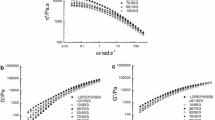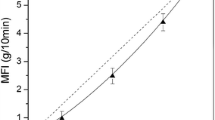Abstract
The dynamic rheological behavior of polypropylene (PP)/low-density polyethylene (LDPE) blending melts at 210 °C and 230 °C was measured by small-amplitude oscillatory shear mode on a rotational rheometer. The complex viscosity and dynamic modulus of pure PP are higher than those of pure LDPE at low frequency. For the blends with dispersion morphologies, Palierne model is applied to fit the storage modulus data and the model almost underestimates the data since most of the experimental dynamic modulus of the blends lay between that of pure PP and pure LDPE. While Lee and Park model predicts the dynamic storage data well for the PP/LDPE blends 90/10, 10/90 and 70/30 blends. For the 30/70 blend, this model describes the data much closer than Palierne model and a little deviation occurs at low frequency. The comparison between the two models’ fitting results indicates interaction among dispersed droplets should be considered.






Similar content being viewed by others
References
Willemse RC, de Posthuma BA, van Dam J et al (1998) Co-continuous morphologies in polymer blends: a new model. Polymer 39(24):5879–5887
Wang H, Zhang Y, Huang Z et al (2016) Experimental and modeling study of the compressive behavior of PC/ABS at low, moderate and high strain rates. Polym Test 56:115–123
Liu WB, Kuo WF, Chiang CJ et al (1996) In situ compatibilization of PBT/PPO blends. Eur Polym J 32:91–99
Zhao Y, Liu Z, Su B et al (2015) Property enhancement of PP-EPDM thermoplastic vulcanizates via shear-induced break-up of nano-rubber aggregates and molecular orientation of the matrix. Polymer 63:170–178
Guo HF, Packirisamy S, Gvozdic NV et al (1997) Prediction and manipulation of the phase morphologies of multiphase polymer blends: 1. Ternary Syst Polym 38:785–794
Reignier J, Favis BD, Heuzey MC (2003) Factors influencing encapsulation behavior in composite droplet-type polymer blends. Polymer 44:49–59
Hobbs SY, Dekkers MEJ, Watkins VH (1988) Effect of interfacial forces on polymer blend morphologies. Polymer 29:1598–1602
Nauman EB, He DQ (2001) Nonlinear diffusion and phase separation. Chem Eng Sci 56:1999–2018
Horiuchi S, Matchariyakul YK, Kitano T (1997) Morphology development through an interfacial reaction in ternary immiscible polymer blends. Macromolecules 30:3664–3670
Jegat C, Virgilio N, Favis BD (2017) Self-assembly of oil microdroplets at the interface in co-continuous polymer blends. Eur Polym J 93:259–271
Li LP, Yin B, Yang MB (2011) Morphology prediction and the effect of core–shell structure on the rheological behavior of PP/EPDM/HDPE ternary blends. Polym Eng Sci 51:2425–2433
Li LP, Yin B, Zhou Y et al (2012) Characterization of PA6/EPDM-g-MA/HDPE ternary blends: the role of core-shell structure. Polymer 53:3043–3051
Fan JF, Cao LM, Huang JR et al (2019) The construction and verification of toughening model and formula of binary poly(lactic acid)-based TPV with co-continuous structure. Mater Chem Phys 231:95–104
Virgilio N, Sarazin P, Favis BD (2011) Ultraporous poly(L-lactide) scaffolds prepared with quaternary immiscible polymer blends modified by copolymer brushes at the interface. Polymer 52:1483–1489
Lee HM, Park OO (1994) Rheology and dynamics of immiscible polymer blends. J Rheol 38:1405–1425
Choi SJ, Schowalter WR (1975) Rheological properties of nondilute suspensions of deformable particles. Phys Fluids 18:420–427
Gramespacher H, Meissner J (1992) Interfacial-tension between polymer melts measured by shear oscillations of their blends. J Rheol 36:1127–1141
Palierne JF (1990) Linear rheology of viscoelastic emulsions with interfacial tension. Rheol Acta 29:204–214
Chen J, Wu D (2014) Poly(trimethylene terephthalate)/poly(butylenes succinate) blend: phase behavior and mechanical property control using its transesterification system as the compatibilizer. Mater Chem Phys 148:554–561
Maani A, Heuzey MC, Carreau PJ (2011) Coalescence in thermoplastic olefin (TPO) blends under shear flow. Rheol Acta 50:881–895
Parpaite T, Otazaghine B, Caro AS et al (2016) Janus hybrid silica/polymer nanoparticles as effective compatibilizing agents for polystyrene/polyamide-6 melted blends. Polymer 90:34–44
Lacroix C, Aressy M, Carreau PJ (1997) Linear viscoelastic behavior of molten polymer blends: a comparative study of the Palierne and Lee and Park models. Rheol Acta 36:416–428
Doi M, Ohta T (1991) Dynamics and rheology of complex interfaces. I. J Chem Phys 95:1242–1248
Grace HP (1982) Dispersion phenomena in high viscosity immiscible fluid systems and application of static mixers as dispersion devices in such systems. Chem Eng Commun 14:225–277
Asthana H, Jayaraman K (1999) Rheology of reactively compatibilized polymer blends with varying extent of interfacial reaction. Macromolecules 32:3412–3419
Liao HY, Tao GL, Liu CL et al (2016) A polypropylene/high density polyethylene blend compatibilized with an ethylene-propylene-diene monomer block copolymer: fitting dynamic rheological data by emulsion models with a physical scheme. J Appl Polym Sci 43709:1–8
Bousmina M (1999) Rheology of polymer blends: linear model for viscoelastic emulsions. Rheol Acta 38:73–83
Graebling D, Muller R, Palierne JF (1993) Linear viscoelastic behavior of some incompatible polymer blends in the melt. Interpretation of data with a model of emulsion of viscoelastic liquids. Macromolecules 26:320–329
Zhang ZY, Qiao JL (1993) Method of estimating interfacial tension in polymer systems. Acta Polymerica Sinca 3:343–347
Wu RJ (1998) Polymer interface and adhesion. Science Press, Beijing
Kwon MK, Cho KS (2016) Analysis of the Palierne model by relaxation time spectrum. Korea-Australia Rheol J 28:23–31
Mellema J, Willemse MWM (1983) Effective viscosity of dispersions approached by a statistical continuum method. Phys A 122:286–312
Onuki A (1987) Viscosity enhancement by domains in phase-separating fluids near the critical point: proposal critical rheology. Physica Rev A 35:5149–5155
Acknowledgements
This work is supported by the Top-notch Academic Programs Project of Jiangsu Higher Education Institutions (TAPP) and the Priority Academic Program Development of Jiangsu Higher Education Institutions (PAPD).
Author information
Authors and Affiliations
Corresponding author
Additional information
Publisher's Note
Springer Nature remains neutral with regard to jurisdictional claims in published maps and institutional affiliations.
Rights and permissions
About this article
Cite this article
Liao, Hy., Liao, Rr., Li, Sq. et al. Rheology of a polypropylene/low-density polyethylene blending melt: Fitting dynamic rheological data by Palierne model and Lee and Park model. Polym. Bull. 79, 4957–4970 (2022). https://doi.org/10.1007/s00289-021-03720-y
Received:
Revised:
Accepted:
Published:
Issue Date:
DOI: https://doi.org/10.1007/s00289-021-03720-y




